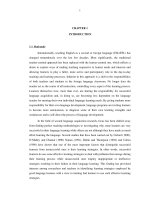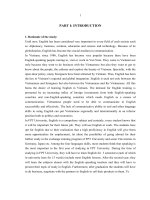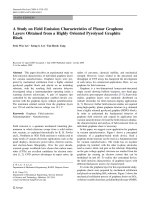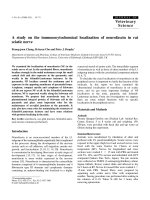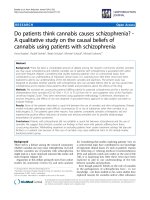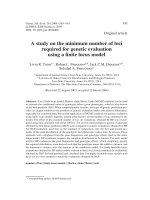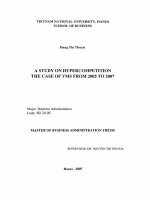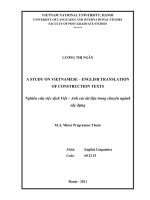A study on manganese catalyzed epoxidation of styrene using online raman and in situ FTIR monitoring techniques
Bạn đang xem bản rút gọn của tài liệu. Xem và tải ngay bản đầy đủ của tài liệu tại đây (15.23 MB, 160 trang )
A STUDY ON MANGANESE CATALYZED EPOXIDATION
OF STYRENE USING ONLINE RAMAN AND IN-SITU FTIR
MONITORING TECHNIQUES
QUAH CHEE WEE
NATIONAL UNIVERSITY OF SINGAPORE
2006
A STUDY ON MANGANESE CATALYZED EPOXIDATION
OF STYRENE USING ONLINE RAMAN AND IN-SITU FTIR
MONITORING TECHNIQUES
QUAH CHEE WEE
(B.Eng.(Hons.), NUS)
A THESIS SUBMITTED
FOR THE DEGREE OF MASTER OF ENGINEERING
DEPARTMENT OF CHEMICAL & BIOMOLECULAR
ENGINEERING
NATIONAL UNIVERSITY OF SINGAPORE
2006
i
Acknowledgements
Embarking on my first journey in research, I have learnt some of the rigors
involved but it also provides me with an insight to how interesting and fulfilling the
actual experience can be. Research can be utterly tedious and involves unassuming
patience cum perseverance working towards making scientific contribution in one’s own
area through well-designed experiments and diligent execution of any possible ideas.
With the completion of this work, I like to thank Dr Carpenter, executive director
of Institute of Chemical and Engineering Sciences (A*Star-ICES) for his encouragement
and concern in my work. I also like to express my gratitude to both supervisors - Prof
Garland and Dr Bujie for their advice. They provide inspiration and motivation for me to
understand the meaning of passion in research work which is important for aspiring
research students. They impart perseverance and innovativeness which are crucial for
young minds to better apply our knowledge to solve problems. I really need to thank my
seniors Dr Chew Wee, Dr Effendi Widjaja, Mr Guo Liangfeng and Mr Zhang Huajun for
their guidance in signal processing. In addition, I also wish to acknowledge the assistance
of Mettler-Toledo for the use of ReactIR instrument for in-situ ATR measurements.
Lastly, I would like to make a special mention of my family and girlfriend, Ms
Chew Meizeng who are always there to support me at the end of the day and colleagues
in ICES. It is with pleasure that I complete my thesis, bearing in mind, the KISS (Keep It
Short and Sweet) principle and present my work in a scientifically concise manner.
T
able
of
C
ontents
ii
TABLE OF CONTENTS
Description Page
Chapter 1 Introduction
1.1 Introduction to Epoxidation 1
1.2 Important Applications of Epoxides 3
1.3 Motivation for Studying Mn-Bicarbonate-H
2
O
2
Catalytic System 4
1.4 Objective and Scope of Study 6
1.5 Outline of Thesis structure 7
Chapter 2 Literature Review
2.1 Overview of Catalysts for Epoxidation 8
2.2 Homogeneous Catalysis for Epoxidation 8
2.2.1 Manganese-Salen Complexes
2.2.2 1,4,7-Triazacyclononane(TACN) Complexes
2.2.3 Metalloporphyrins- Iron and Mn Porphyrin Complexes
2.2.4 Methyltrioxorhenium (MTO) Catalyst
2.2.5 Polyoxometalates- Peroxotungstates/Peroxomolybate
2.2.6 Iron and Manganese Pyridyl-Amine Complexes
2.3 Heterogeneous Catalysis for Epoxidation 22
2.3.1 Zeolites and Hydrotalcite Systems
2.3.2 Homogeneous Catalysts Anchored onto Silica Support
2.4 Reaction Controlled Phase Transfer Catalysts 25
2.5 Comparison of Various Catalysts 27
2.6 Introduction to Chemometrics 29
2.7 Band Target Entropy Minimization (BTEM) 29
2.7.1 Introduction to BTEM
2.7.2 Applicability of BTEM
2.7.3 Singular Vector Decomposition (SVD)
2.7.4 Shannon Entropy Minimization
2.7.5 Corana’s Self-Annealing (SA) Optimization Method
2.7.6 Band Target Entropy Minimization (BTEM)
T
able
of
C
ontents
iii
2.7 Band Target Entropy Minimization (BTEM) 29
2.7.7 BTEM Pseudo Algorithm
2.7.8 BTEM as an Effective Data Analysis Tool
Chapter 3 Experimental and Theory
3.1 Nuclear Magnetic Resonance (NMR) Spectroscopy 45
3.3.1 Investigations with
13
C NMR Spectroscopy
3.3.2 Preparation of Standard Reagents
3.3.3 Exsistence of Peroxocarbonates and Mn-Complex
3.2 Online Raman Spectroscopy 49
3.2.1 Investigations with Online Raman Spectroscopy
3.2.1.1 Basic Experimental Set-up
3.2.1.2 Preparation of Reagents
3.2.1.3 Aspects of Experimental Design
3.2.2 Data analysis of Online Raman data
3.2.2.1 Application of BTEM
3.2.2.2 Singular Value Decomposition (SVD)
3.2.2.3 Band Targeting Using V
T
Vectors
3.2.2.4 Pure Component Spectra Reconstruction
3.2.2.5 Comparison of Reconstructed Spectra
3.2.2.6 Concentrated Profile of Individual Species
3.2.3 Assignment of Characteristic Peaks of Styrene and Epoxide
3.2.4 Spectral Analysis of Mn-Complex
3.2.4.1 Characteristic Raman Peaks of Mn-Complex
3.2.4.2 Embedded Peak of Mn-Complex
3.2.5 Control Experiments
3.2.5.1 Expt 1– Preparation of Mn-Complex in DMF
3.2.5.2 Expt 2– Preparation of complex without Mn
2+
3.2.5.3 Expt 3– Preparation of complex without HCO
3
-
3.2.5.4 Expt 4– Interactions between DMF and Water
3.2.5.5 Expt 5– Interactions between DMF and Mn
2+
3.2.5.6 Expt 6– Interaction of HCO
3
-
with H
2
O
2
3.2.5.7 Expt 7– Artifact Peak belonging to H
2
O
3.2.6 Assignment of Vibration Modes in Mn-Complex
3.2.6.1 Metallic-Oxygen (Mn-O) Vibration Mode
3.2.6.2 Peroxo (O-O) Vibration Mode
3.2.6.3 Carbon-oxygen (C-O) and Carbonyl Carbon
(C=O) modes
T
able
of
C
ontents
iv
3.2 Online Raman Spectroscopy
3.2.7 Postulated Structure for Mn-Complex Solvated in DMF
3.2.8 Existence of [ML
n
(CO
4
)] species (M= Fe, Rh, Pt, Pd, Ni)
3.2.9 Evidence for Existence of Manganese-Peroxocarbonate
Complex
3.3 Introduction to UV-Vis Spectroscopy 88
3.3.1 Introduction to UV-Vis Spectroscopy
3.3.2 Preparation of Standard Reagents
3.3.3 UV-Vis Analysis of Pure Reagents
3.3.4 UV-Vis Analysis of Mn-Complex (LMCT)
3.4 Reaction Calorimetry 93
3.4.1 Online Calorimetry for reaction studies
3.4.2 Experimental Design
3.4.3 Reaction Studies I: Two-Step Epoxidation
3.4.3.1 Step 1 - Preparation of Mn-complex
3.4.3.2 Step 2 - Epoxidation of Styrene
3.4.4 Reaction Studies II: One-Pot Epoxidation
3.5 In-situ Mid-Infrared Attenuated Total Reflection 99
3.5.1 Singular Value Decomposition of ATR Spectra
3.5.2 Band Targeting and Corana’s Self-Annealing
3.5.3 Pure Component Spectra Reconstruction
3.5.4 Effect of Dosing on Concentration Profile
Chapter 4 Results and Discussions
4.1 Interpretation of Experimental Results 106
4.2 Investigation on Role of Reagents 107
4.3 Proposed Reaction Mechanism 109
4.4 Purpose of Kinetics Studies 112
4.5 Order and Molecularity in the Rate Law 113
4.6 Kinetic Studies 114
4.6.1 Rate Expressions and Rate Equation
4.6.2 Determination of Overall Rate Constant
T
able
of
C
ontents
v
Chapter 5 Conclusions and Future Work
5.1 Review of Mn-catalyzed Epoxidation 117
5.2 Major Significant Findings 117
5.3 Recommendations for Future Work 118
References 119
ACKNOWLEDGEMENTS i
TABLE OF CONTENTS ii-v
SUMMARY vi
LIST OF TABLES vii-viii
LIST OF FIGURES ix-xiv
LIST OF SCHEMES xv
LIST OF SYMBOLS xvi-xvi i
Summary
vi
Summary
Catalytic epoxidation of styrene using a cheap and effective combination of
MnSO
4
salt and bicarbonate-H
2
O
2
solution in DMF was successfully carried out with
complete conversion and up to 90% yield in about 1 h. The use of 30% H
2
O
2
oxidant is in
line with current green chemistry practices as H
2
O
2
gives environment friendly
byproducts such as H
2
O and O
2
in contrast to hydrocarbons if organic peroxides are used.
Furthermore, manganese is also relatively non-toxic compared to traditional tungsten
catalysts. This catalytic system is ligand-free and does not require any additives, carried
out in DMF which is more environmentally compatible as opposed to halogenated
solvents.
Such advantageous catalytic system thus provides the motivation to study the
reaction mechanism and carry out kinetic studies using online Raman, in-situ FTIR,
13
C
NMR and UV-Vis spectroscopy coupled with application of Band Target Entropy
Minimization (BTEM) chemometric method. The active epoxidizing agent (manganese
peroxocarbonate complex) was effectively elucidated from the array of online Raman
data using BTEM. The characteristic Raman vibration modes of this complex suggest a
bidentate coordination between the manganese center and a singular carbon-containing
peroxocarbonate group, simultaneously supported by both
13
C NMR and UV-Vis results.
A plausible mechanism was then proposed. Based on this mechanism, the overall reaction
rate constant was subsequently computed, which will be useful for reactor sizing and
scale-ups.
L
ist of Tables
vii
List of Tables
Table 2-1 Comparison of various epoxidation catalysts.
Table 3-1 Amount of reagents used in Raman experiment.
Table 3-2 Band selection for targeting.
Table 3-3 Characteristic peaks of Mn-complex.
Table 3-4 Embedded bands and corresponding BTEM-resolved peaks.
Table 3-5 Control experiments for comparison.
Table 3-6 Shifts in Raman bands due to H-Bonding between DMF and water.
Table 3-7 Reported peak assignments for ν(Mn-O) mode.
Table 3-8 Assigned complex peaks.
Table 3-9 UV cut-offs of solvents taken for absorbance of 1.00 in a 10.0 mm cell
versus distilled water.
L
ist of Tables
viii
Table 3-10 Amount of reagents used.
Table 3-11 Targeted bands.
Table 4-1 Role of reagents.
L
ist of Figures
ix
List of Figures
Figure 1-1 Electrophilic attack on alkenes to form epoxides.
Figure 1-2 Chirally catalyzed epoxidations by Sharpless.
Figure 1-3 (a) Various epoxide-derived products and
(b) Coatings and additives from epoxidation of natural products.
Figure 2-1 (a) Berkessel’s catalyst with tethered imidazole and
(b) Katsuki’s unfunctionalized Mn-salen complex.
Figure 2-2 (a) Jacobsen’s catalyst and (b) Schiff-base Mn-salen complex.
Figure 2-3 Structure of 1,4,7-Triazacyclononane (TACN).
Figure 2-4 Dinuclear complexes with (a) Oxo, (b) Peroxo and (c) Carboxylate
centres.
Figure 2-5 Modified TACN as epoxidation catalysts with H
2
O
2
-oxidant.
Figure 2-6 (a) Chlorinated Mn-porphyrin complex,
(b) Mn-porphyrin mediated epoxidation using imidazole and
(c) N-alkyl imidazole and benzoic acid.
Figure 2-7 (a) Iron porphyrin and
(b) Iron porphyrin mediated epoxidation with electron poor ligands and
protic solvent.
L
ist of Figures
x
Figure 2-8 Additives used in MTO-catalyzed epoxidations using 30% H
2
O
2
.
Figure 2-9 Venturello epoxidation catalyst.
Figure 2-10 Epoxidation in benign solvent with Noyori’s catalyst.
Figure 2-11 Jacobsen iron catalyst system for epoxidaton of terminal aliphatic
alkenes with 50% H
2
O
2
.
Figure 2-12 Ligands used in nonheme biomimetic catalysts.
Figure 2-13 Feringa’s dinuclear Mn-complex for alkene epoxidation with 30% H
2
O
2
.
Figure 2-14 Hydrotalcite epoxidation using 30% H
2
O
2
(a) Benzonitrile as peroxide carrier and
(b) Iso-butyramide as peroxide carrier.
Figure 2-15 Proposed reaction mechanism for hydrotalcite epoxidation using 30%
H
2
O
2
and iso-butyramide as peroxide carrier.
Figure 2-16 (a) Mn-porphyrins and (b) Mn-TACN anchored on silica.
Figure 2-17 Self-Recoverable phosphate/tungstic acid system based on catalyst
solubility.
Figure 2-18 Reaction controlled phase transfer catalyst based on action of H
2
O
2
.
Figure 2-19 Pure component spectra elucidated from BTEM.
L
ist of Figures
xi
Figure 3-1
13
C NMR spectrum of
(a) H
13
CO
3
in DMF solvent, (b) Formation of H
13
CO
4
-
in DMF and
(c) Formation of Mn-complex with single
13
C atom at 124 ppm
(*) Denotes DMF solvent peaks.
Figure 3-2 Experimental set-up for online Raman spectroscopy monitoring.
Figure 3-3 Experimental procedure and dosing profile. (S denotes spectra number).
Figure 3-4 Raw Raman spectra from online monitoring.
Figure 3-5 Right singular V
T
vectors obtained from SVD.
Figure 3-6 Singular values of V
T
vectors.
Figure 3-7 Normalized BTEM-constructed pure component spectra.
Figure 3-8 Comparing BTEM-reconstructed spectra of Mn-complex with pure (a)
DMF, (b) Styrene and (c) Styrene oxide.
Figure 3-9 Concentration profile during epoxidation.
Figure 3-10 Standard Nicolet FT-Raman spectra from Aldrich Sigma Chemicals*–
(a) Styrene, (b) Styrene epoxide, (c) Benzene and (d) Ethylbenzene.
*
Figure 3-11 3D reaction profile showing characteristic
(a) Epoxide peak (Increasing at 1254 cm
-1
) and
(b) Styrene peak (Depleting at 1631cm
-1
).
L
ist of Figures
xii
Figure 3-12 Normalized BTEM reconstructed spectra of Mn-complex.
Figure 3-13. Comparison of BTEM reconstructed spectrum of Mn-complex with
online Raman spectra.
Figure 3-14 Gradual peak shifting from styrene to styrene oxide.
Figure 3-15 Deconvoluted spectra.
Figure 3-16 BTEM reconstructed spectra without Mn
2+
.
Figure 3-17 BTEM reconstructed spectra without HCO
3
-
.
Figure 3-18 Hydrogen bonding as a result of mixing DMF and water.
Figure 3-19 Interactions of Mn
2+
(aq)
with DMF medium.
Figure 3-20 (a) Hexahydrated Mn
2+
(aq)
ions versus (b) Mn
2+
(aq)
in DMF medium.
Figure 3-21 Raman spectra of (a) O
2
and (b) CO
2
gases at 1550 and 2329 cm
-1
.
Figure 3-22 Observed artifact peak of Raman spectrometer.
L
ist of Figures
xiii
Figure 3-23 Comparing ν(Mn-O) in
Mn-complex with standard Mn
x
O
y
species.
Figure 3-24 Comparing ν(Mn-O) of
Mn-complex at 404 cm
-1
with standard Mn
x
O
y
species. (*) Denotes artifact peak as explained in Section 5.6.7.
Figure 3-25 Standard Raman spectra* showing ν(O-O) in various peroxides.
*
Figure 3-26 Comparison of ν(O-O) in Mn-complex with ν(O-O) in H
2
O
2
.
Figure 3-27 Characteristic peaks of Mn-complex representing
(a) Mn-O-C vibration, (b) ν(C=O) vibration,
(c) Mixed vibration δ(O
2
CO) and
(d) Deformation δ(MnO
2
CO) modes.
Figure 3-28 Postulated Mn-peroxocarbonate complex solvated in DMF D) medium.
Figure 3-29 Assignment of possible vibration modes in Mn-complex.
Figure 3-30 Existence of similar d-block transitional metal complexes containing
peroxocarbonate bidentate group.
Figure 3-31 Individual component spectra and Mn-complex spectra.
Figure 3-32 (a) Hexahydrated Mn
2+
(aq)
ions versus (b) Mn
2+
(aq)
in DMF medium.
L
ist of Figures
xiv
Figure 3-33 Resultant spectra of Mn-complex solution.
Figure 3-34 Reaction calorimeter (RC1e), Mettler-Toledo.
Figure 3-35 1
st
step reaction profile during preparation of Mn-complex - (a) Reaction
temperature, T
r
, (b) Temperature difference between reaction mixture,
T
r
and reactor wall temperature, T
a
, (c) Gas generation and (d) pH.
Figure 3-36 2
nd
step reaction profile during epoxidation of styrene - (a) Temperature,
(b) pH, (c) Gas generation and (d) Conversion – Selectivity.
Figure 3-37 One-pot reaction profile during epoxidation of styrene -(a) Temperature,
(b) pH, (c) Gas generation and (d) Conversion – Selectivity.
Figure 3-38 (a) Experimental set-up and (b) Resultant 3D ATR spectra.
Figure 3-39 Right singular V
T
vectors obtained from SVD.
Figure 3-40 Singular values of V
T
vectors.
Figure 3-41 BTEM reconstructed spectra (a) DMF, (b) Styrene and (c) Epoxide.
Figure 3-42 Relative concentration profile during reaction.
Figure 4-1 Experimental versus simulated concentration profiles.
L
ist of Schemes
xv
List of Schemes
Scheme 1-1 Catalytic cycle for Mn-mediated epoxidaton.
Scheme 1-2 Mn-catalyzed epoxidation of styrene with bicarbonate-H
2
O
2
solution.
Scheme 2-1 Catalytic cycle in MTO mediated epoxidations with H
2
O
2.
Scheme 3-1 Formation of manganese-peroxocarbonate complex in DMF.
Scheme 3-2 Mn-based epoxidation of styrene.
Scheme 3-3 Proposed reaction for (a) HCO
3
-
and H
2
O
2
to form HCO
4
-
,
(b) 1
st
step monodentate coordination of HCO
4
-
with Mn
2+
(aq)
in DMF
(c) 2
nd
step bidentate coordination of HCO
4
-
with Mn
2+
(aq)
in DMF.
Scheme 4-1 Proposed mechanism for Mn-catalyzed epoxidation.
L
ist of Symbols
xvi
List of Symbols
RR Diastereomer of RS and SR enantiomer
SS Diastereomers of RS and SR enantiomer
% ee Percentage enantiomeric excess
eq. Equivalent amount
mol% Moles percentage
cm
-1
IR wavenumbers or Raman shift
A Absorbance in spectroscopic measurements
λ Eigenvalues in the Σ vectors
ε Error matrix to account for errors or surrounding noise
V
T
Right singular orthonormal vectors in SVD
a
s x ν
Pure component matrix , BTEM
a
ˆ
Pure component absorptivities , BTEM
T Transformation or rotation matrix in optimization
I Identity matrix
O Zero matrix
U Orthonormal singular vector
Σ Unity diagonal matrix in SVD
c
ˆ
Estimated concentration of component
G Minimized entropy
h Shannon Entropy function
P Penalty function in optimization
γ
a,
γ
c
Penalty factors in optimization
δ NMR signal, ppm
∆ Deviation or difference in values
ν(xxx) Vibration mode of bonds, IR or Raman
δ (xxx) Mixed or deformation modes, IR or Raman
a.u Arbituary units
π Pi electron orbitals in chromophores
πÆ π Pi to Pi electron transitions
e
g
Higher energy level orbital of transition metal
t
2g
Lower energy level orbital of transition metal
d
π
Pi orbital of d-block elements
λ
max
Maximum absorbance values in UV-Vis spectrum
LMCT Ligand to metal charge transfer for coordinated metallic complexes
T
r
Reaction temperature in the mixture
T
a
Jacket temperature
t Reaction time
C
A
Reactant concentration as function of time due to reaction
C
AD
Reactant concentration as function of time due to reaction and dosing
N
R
Reacting number of moles of reactant as function of time due to reaction
V
o
Initial reaction volume
L
ist of Symbols
xvii
ν Dosing rate of buffer solution
TON Turnover number as indicator of reaction efficiency, hr
-1
V
r
Volume of reactor
N
A
Number of moles of reactant A
F
AO
Inlet molar flow rate of reactant A
n Order of reaction
x
A
Conversion of reactant A
-r
A
Reaction rate with respect to reactant A
k’ Overall reaction rate constant
k
i
Individual reaction rate constants
k Pseudo overall reaction rate constant
C
hapter 1 – Introduction
1
CC
H
H
H
H
[O]
CC
O
H
H
H
H
Manganese Catalyzed Epoxidation
1.1 Introduction to Epoxidation
Epoxidation is an unique reaction involving partial oxidation which has long been
studied by scientists. It is basically a chemical reaction in which an oxygen atom is joined
to an olefinically unsaturated molecule to form cyclic, three-membered oxiranes known
as epoxides shown in Figure 1-1. The three-membered ring structure in epoxides is
strained and hence unstable, rendering them acid-sensitive and vulnerable to hydrolysis to
form diols.
Figure 1-1. Electrophilic attack on alkenes to form epoxides.
Due to its reactivity, epoxides are valuable and useful intermediary building
blocks for various organic syntheses, thus creating exciting possibilities for building new
complex molecules. Epoxides, especially chiral epoxides (asymmetric synthesis) are very
important compounds in the synthesis of natural products, pharmaceuticals and
chemicals. Tremendous research efforts are committed in the area of catalysis for
epoxidation.
C
hapter 1 – Introduction
2
Notably, K.Barry Sharpless
1
et al. reported a catalyst formed from titanium tetra
(isopropoxide) and enantiomerically pure diethyl tartarate
(DET, either RR or SS) with
tert-butyl hydroperoxide (TBHP)
oxidant to prepare 2,3-epoxyalcohols. This gives good
enantioselective epoxidation of prochiral 1° and 2° allylic alcohols as shown in Figure 1-
2 below.
In 2001, Sharpless obtained the Nobel prize for his work on asymmetric
oxidations, co-shared with William S. Knowles and Ryoji Noyori. His method opened up
ways for great structural diversity with wide applications in both academic and industrial
research.
S/S-diethyltartrate
(-)-DET
R/R-diethyltartrate
(+)-DET
R''
R''
R'
OH
O
R'
R''
R''
OH
O
R'
R''
R''
OH
Ti(OCH(CH
3
)
2
)
4
OOH
70 ~ 90% yield
≥ 90% ee
Figure 1-2. Chirally catalyzed oxidations by Sharpless.
C
hapter 1 – Introduction
3
1.2 Important Applications of Epoxides
Epoxides can be used to manufacture a variety of product line for cosmetics,
chemical commodities, epoxy resins, pharmaceuticals and, paintings shown in Figure 1-3.
Yearly, 4.5 million tons of propylene/butene oxides are produced through non-catalytic
chlorohydrin process where large consumption of Cl
2
leads to equipment corrosion or
Halcon method where auto-oxidation of ethylbenzene/isobutane is used to make
alkylhydroperoxide (oxidant) for epoxidation of propylene to propylene oxide. The
versatility of valuable epoxides puts the reaction under the limelight.
Figure 1-3. (a) Various epoxide-derived products and (b) Coatings and additives from
epoxidation of natural products.
a.
b.
C
hapter 1 – Introduction
4
Scheme 1-1. Catalytic cycle for Mn-mediated epoxidation.
1.3 Motivation for Studying Mn-Bicarbonate-H
2
O
2
Catalytic System
There is widespread interest in manganese complexes due to their vantage of
applications in organic synthesis and catalysis.
2
In addition, manganese compounds have
attracted special attention regarding their important role in the material science and
bioinorganic chemistry.
3
However, synthesizing of such catalytic complexes is still a
challenge for the chemists along with the investigation of spectroscopic and structural
characteristics of these molecules.
Given the importance of epoxidation, in a recent 2001 JACS paper, Burgess et al.
identified simple metal salt – i.e. MnSO
4
as effective epoxidation catalyst via large-scale
parallel high throughput screening methodology.
4,5
More than 30 d-block and f-block
transition metal salts were screened for epoxidation activity under similar conditions, all
in the presence of bicarbonate-H
2
O
2
solution. Other than CrCl
2
and Fe
2
(SO
4
)
3
, which
exhibited some activity, only catalytic amounts of MnSO
4
salts (0.1~1 mol %) coupled
with bicarbonate-H
2
O
2
solution prove to be the most effective for epoxidation in either
t
BuOH or DMF solvents without the use of additives (Scheme 1-1).
H
2
O
2
+ HCO
3
-
HCO
4
-
+ H
2
O
DMF or
t
BuOH
pH 8.0
O
R
1
R
2
R
R
3
R
1
R
R
3
R
2
Mn
2+
C
hapter 1 – Introduction
5
These results are amazingly exciting as complete epoxidation can be achieved
successfully within 1 hr in DMF. In this work, the Mn-bicarbonate-H
2
O
2
system will be
studied in detail given its numerous advantages over other classical “non-green”
processes using organic peroxides oxidants.
Advantages of Mn-Bicarbonate-H
2
O
2
Oxidation: -
1. Cost and Availability: Manganese salts are relatively cheap and available.
2. Toxicity: Manganese is relatively non-toxic compared to rhenium or tungsten-
based catalysts such as MeReO
3
and WO
4
2-
.
3. Synthesis & Use of Ligands : Mn-HCO
3
-
-H
2
O
2
catalytic system is ligand-free.
4. Environmental Impact: H
2
O
2
is environmentally benign as it generates H
2
O and
O
2
as sole by-products. Both
t
BuOH and DMF solvents are more environmentally
compatible as opposed to halogenated hydrocarbons or nitromethane and hence
more appropriate for process chemistry, relatively safe, non-halogenated and
inexpensive.
5. Effectiveness of Oxidant: H
2
O
2
has a high content of active oxygen species and
rather inexpensive compared to organic peroxides and peracids. Additives are not
required.
6. Ease of Separation: Most epoxides obtained are easily isolated via a simple
extraction into an apolar solvent (pentane or diethyl ether) and in many cases,
after removal of the solvent, further purification is unnecessary.
C
hapter 1 – Introduction
6
+
O
H
2
O
2
H
2
O
+
25 DegC, pH 8-9
Mn
2+
, HCO
3
-
1.4 Objective and Scope of Study
Burgess reported that electron rich alkenes are most reactive in Mn-based
catalytic system. Thus, the epoxide yields are high for aryl-substituted alkenes in contrast
to less reactive substrates such as dialkyl-substituted alkenes because higher H
2
O
2
concentrations and special additives are required to obtain good yields.
In this work, investigation of reaction mechanism and kinetic studies on the
catalytic epoxidation will be carried using styrene as model substrate. With electron rich
styrene, the use of H
2
O
2
will be minimal and no additives are required which may
complicate the analysis of the reaction in Scheme 1-2. Various analytical techniques
(Raman, FT-IR, UV-Vis,
13
C NMR) and BTEM chemometric method will be used to
determine the active manganese complex formed in DMF and map out the reaction
mechanism. Based on this mechanism, the rate expressions will be formulated for kinetic
studies to compute the overall rate constant, which will be useful for scale-ups and
reactor sizing.
Scheme 1-2. Mn-catalyzed epoxidation of styrene with bicarbonate-H
2
O
2
.


